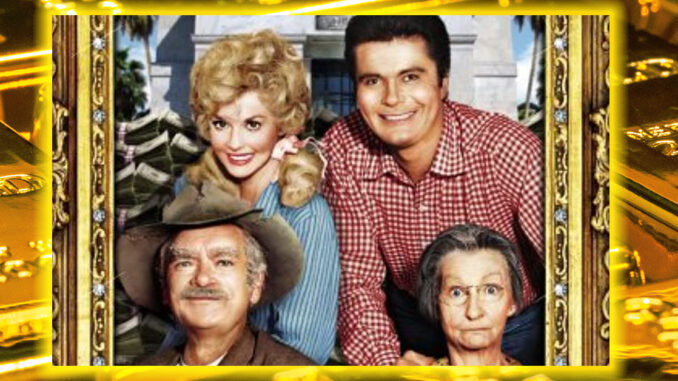
The Beverly Hillbillies’ smash success completely confused critics
Early reviews struggled to find “deep significance” in the Clampetts’ universal appeal.
When Jed Clampett first struck oil in The Beverly Hillbillies premiere, everyone working on the show was sure that audiences would recognize the show was comedy gold.
In 1962, Irene Ryan, who played Granny, told the Los Angeles Evening Citizen News that this part was the grandmother role she’d been waiting for her whole career for.
“From the first moment I heard of The Beverly Hillbillies, I just drooled for the part of Granny,” Ryan said. “Now, I feel that Irene Ryan at heart is Granny.”
Reading over The Beverly Hillbillies creator Paul Henning’s first script for the pilot, Ryan instinctively felt it was funnier than other TV comedies.
However, it wasn’t until filming started and she heard the reactions from the crew that she knew the show was destined to be a huge success.
“We fall apart laughing on the set,” Ryan told the St. Louis Globe Democrat in 1962. “We hope that is a good sign. The technicians who work on these film things in Hollywood are a super critical lot. When they bust up laughing, we think the home audience will do the same.”
Buddy Ebsen, who played Jed Clampett, was so confident in his new show, he invited a TV critic from the Salt Lake Tribune to watch them shoot the pilot.
The critic reported that he watched enthralled, as he saw Buddy “going through a long and difficult take.”
This lucky bystander became one of the few critics to accurately predict what otherwise to many critics felt like The Beverly Hillbillies’ “unlikely” success.
That critic wrote before the show premiered: “I believe I can predict that Jed Clampett and the other Beverly Hillbillies will find an enthusiastic and responsive audience.”
And right away, after the premiere, that critic was proven right, as The Beverly Hillbillies shot to the top of the Nielsen ratings and stayed there.
The ensemble cast’s popularity surpasses major TV stars like Andy Griffith, Dick Van Dyke and Lucille Ball to take the top position, becoming by far the most popular TV show on air.
Before The Beverly Hillbillies shook up TV ratings, critics had predicted that 1962 would be the year of a new TV trend where audiences craved hit dramas focused on World War II.

They were shocked to see more people interested in the Clampetts than shows like Combat!
Hollywood critic Cynthia Lowry insisted there had to be “deep significance” in viewers’ rampant interest in The Beverly Hillbillies.
Noting that the sitcom was “unblushingly loaded with corny humor and preposterous situations,” Lowry proceeded to guffaw that this could be the very formula that helped The Beverly Hillbillies become “the most popular television show in the nation.”
Noting that seven of the top 11 shows were comedies, she wrote in sincere shock that “there is a sharp indication” that “the public television turns on its set mainly in hope of being amused and lightly entertained.”
Imagine that!?
And for the record, when those viewers back in 1962 did want drama, it wasn’t WWII stories they sought, Lowry said, but Westerns.
In her column, Lowry failed in her mission to find that “deep significance,” proclaiming the Clampetts’ success an anomaly:
“Students of television will find it hard to explain the quick, dramatic success of The Beverly Hillbillies, which received an unmerciful drubbing in the hands of critics earlier in the season,” Lowry said.
Perhaps the most extreme “drubbing” came from United Press International’s Hollywood critic Rick Du Brow, who watched the early episodes and declared that The Beverly Hillbillies only became a hit because it appealed to the most basic viewer.
He went on a rather dramatic rant, inferring that The Beverly Hillbillies stole the top place in the ratings:
“The most impressive thing about the show is not its quality, but the almost awesome, premeditated commercialism that put it across,” Du Brow wrote. “It is not the sort of accomplishment that makes the cockles of one’s heart glow with admiration. This might be a good day to remember that the best man does not always win and that crime, unfortunately, often pays.”
But The Beverly Hillbillies proves that even the loudest and whiniest critics only have power to push ratings when audiences don’t know what they like.
Within its first week, one critic wrote that the sitcom had become a “sleeper” hit precisely because the fans who tuned in were the “we-never-miss-it” type of fan.
These massive audiences didn’t need to be told to watch The Beverly Hillbillies.
Irene Ryan thought that viewers liked the show so much because it was like watching a “live comic strip.” Her costar Buddy Ebsen agreed that the characters were fully formed and dependable for a laugh.
“The foundation for the series is the complete and sharp contrast of the Clampetts with the people surrounding them,” Ebsen told The Salt Lake Tribune in 1962.
